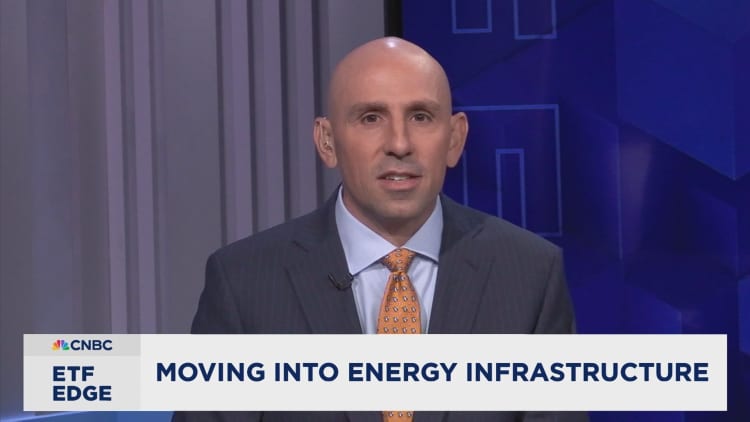- The Trump administration has promoted an energy policy favorable to oil and gas, but the utilities sector within the S&P 500 has been the much stronger performer this year.
- The Utilities Select Sector SPDR (XLU) has tripled the return generated by the Energy Select Sector SPDR (XLE) this year. Meanwhile, the SPDR S&P Oil & Gas Exploration & Production ETF (XOP) has declined by roughly 3%.
- ETF experts say playing energy through the electrification theme should be a sustainable investment trend as energy demand in the U.S., as well as electricity prices, climb in the decades ahead.

The traditional approach to investing in the energy sector going back decades has often come down to making sure a portfolio has exposure to the “majors” — integrated oil and gas stocks like Exxon Mobil and Chevron, which have also paid reliable dividends.
There are times when it hasn’t worked well in recent history — such as during the peak existential fears over the past decade about an oil industry on the way out as a global source of power — but it has done reasonably well since that panic ended. Over the past five years, whether it’s the market performance of Exxon Mobil, or the Energy Select Sector SPDR (XLE), returns have been strong after bottoming out.
But this year, even as Exxon Mobil, Chevron, and energy stocks as a category have produced positive returns, they have not been the big winners for investors playing the energy theme of the future, according to Paul Baiocchi, head of fund sales and strategy at SS&C ALPS Advisors.
He pointed to year-to-date outflows among investors in XLE of roughly $7 billion, the largest and most liquid energy market ETF. Some of that may be related to fears that the global economy will slump as a result of President Trump’s trade war, and as oil prices remain under pressure, the shares of oil and gas stocks will face greater headwinds.

But it’s also a sign of a broader change in how investors think about ways to gain energy exposure.
“It speaks to the fact that advisors and investors are starting to think about energy more in terms of power than just crude oil and natural gas,” Baiocchi said on this week’s CNBC “ETF Edge.”
“The conversation about energy is evolving beyond simply, ‘I have to own the large majors,'” he said.
His firm has long offered a way to play a more concentrated bet within the broader energy sector, led by its 15 year-old Alerian MLP ETF (AMLP), which focuses on energy infrastructure such as pipelines and has seen net inflows this year.
But the story behind the flight from XLE has a lot to do with the expectations for big changes in the power generation sector in the U.S., and decades of transformation ahead for the electric grid as demand surges, spurred by factors such as AI data centers. Some of Trump’s policy priorities play into this trend as well, including support for U.S. artificial intelligence development in a new tech arms race against China, bringing manufacturing back to the U.S., and the promotion of nuclear power.
“We’re talking about incorporating nuclear in a way we haven’t in decades,” Baiocchi said. “The mix of what generates electricity is evolving and the way investors play energy is evolving.”
Jack Clark, co-founder of AI company Anthropic, said at a recent summit where big tech companies met with energy leaders that it estimates 50 gigawatts of new power is needed by 2027, equivalent to about 50 nuclear reactors.
While XLE has seen outflows this year, its utilities sector comp the Utilities Select Sector SPDR (XLU), has seen inflows near $3 billion and has tripled the performance of XLE, up roughly 12% this year versus 4% for the broader energy sector.

According to Malcolm Dorson of Global X ETFs, who appeared alongside Baiocchi on “ETF Edge,” the investor thinking on energy is changing as power generation becomes central to “all the technologies of tomorrow” and a huge surge in demand begins.
“Not only AI, but electric vehicles and large factories, and the big picture is that the U.S. is sort of not ready for all of this,” Dorson said. Global X has launched an ETF focused on the theme, the Global X U.S. Electrification ETF (ZAP). “The U.S. needs to produce about 45% more electricity than it produces today by 2040, after almost two decades of stagnant demand,” he said.
And that demand will also mean higher prices paid by electricity consumers, which are expected to continue to outpace general inflation in the years ahead, as they have since 2022. Electricity prices have nearly doubled the inflation rate for all goods and services in 2025, and the U.S. Energy Information Administration estimated in May that retail electricity prices would outpace inflation through 2026.
The ETF experts also weighed in on the impressive performance run for international stocks in 2025, sleeper markets like Argentina and Greece, whether it’s time to take some profits, and where to place overseas bets next. You can review that debate in this week’s full ETF Edge show.
Sign up for our weekly newsletter that goes beyond the livestream, offering a closer look at the trends and figures shaping the ETF market.












